开头是鸡蛋,后面全靠编!!!
========================================================
1.默认静态资源映射路径以及优先顺序
Spring Boot 默认为我们提供了静态资源处理,使用 WebMvcAutoConfiguration 中的配置各种属性。
建议大家使用Spring Boot的默认配置方式,提供的静态资源映射如下:
-
classpath:/META-INF/resources
-
classpath:/resources
-
classpath:/static
-
classpath:/public
制作【四个同名】的图片,分别在图片上标注对应要放在的【静态资源文件夹】下

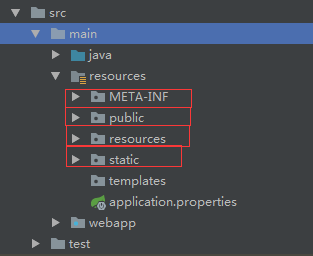
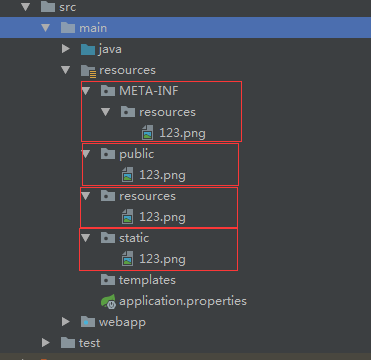
一定要重启,让项目重新加载目录。然后再进行访问
访问地址:http://localhost:8080/123.png
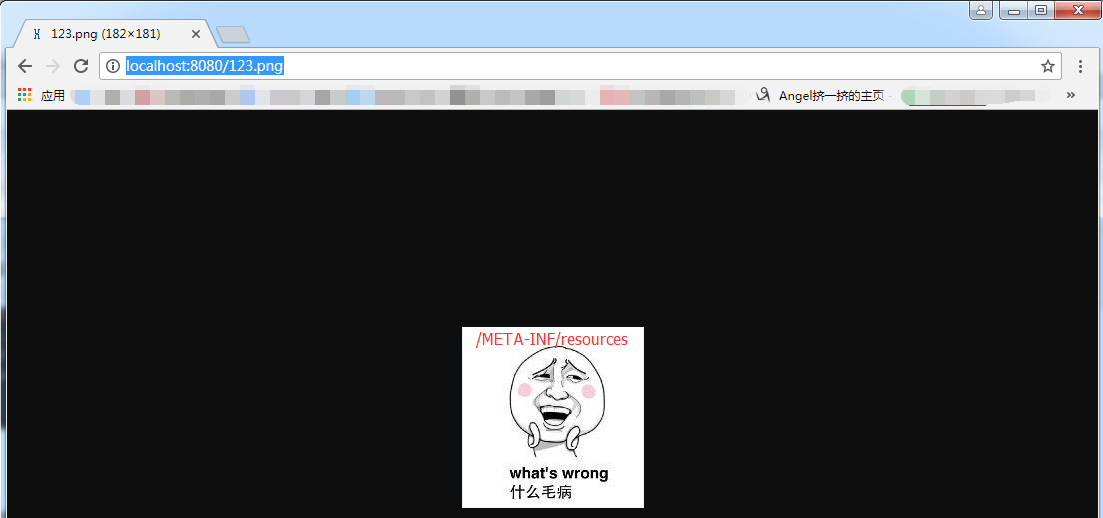
然后把这个目录下的图片删除,依次验证,完成后得出结论:
上面这几个都是静态资源的映射路径,优先级顺序为:META-INF/resources > resources > static > public
除此之外,这几个映射路径下可以放置任何的静态资源都可以被浏览器访问到。
查看完整的配置文件:http://www.cnblogs.com/sxdcgaq8080/p/7724506.html
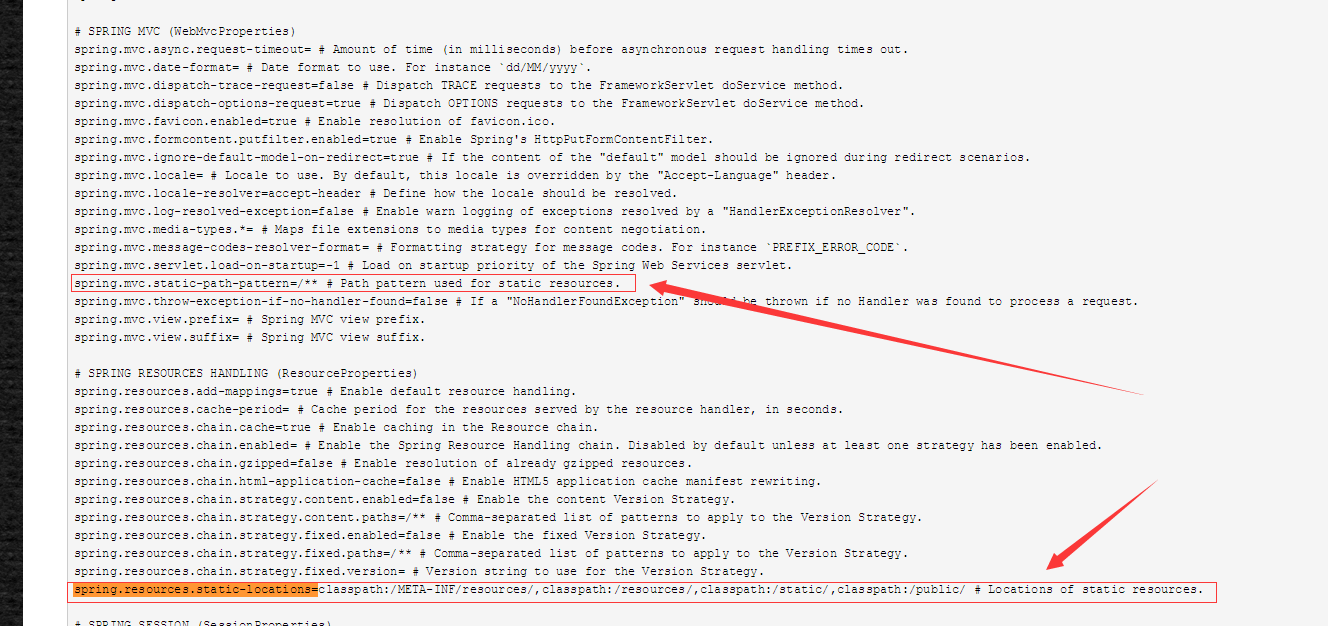
可以看到
spring.mvc.static-path-pattern=/** 静态资源的映射路径模式就是localhost:8080/下面,那比如访问静态资源路径下的图片就是localhost:8080/123.png
如果更改为
spring.mvc.static-path-pattern=/sxd/** 那访问的时候就需要访问localhost:8080/sxd/123.png
spring.resources.static-locations=classpath:/META-INF/resources/,classpath:/resources/,classpath:/static/,classpath:/public/
规定 静态资源映射路径就是根目录下的这几个,如果想要配置更多,请再以,逗号分隔跟在后面写就好了
2.继承WebMvcConfigurerAdapter类,在保留spring boot的配置情况下,添加自定义的额外配置
实现自定义的额外配置的前提,是自定义一个配置类,并使用注解@Configuration
package com.sxd.util; import org.springframework.context.annotation.Configuration; import org.springframework.web.servlet.config.annotation.WebMvcConfigurerAdapter; @Configuration public class MyConfig extends WebMvcConfigurerAdapter { }
2.1通过重写 WebMvcConfigurerAdapter 类的addResourceHandlers()方法,实现添加自定义的静态资源映射地址
实现方式如下:


package com.sxd.util; import org.springframework.context.annotation.Configuration; import org.springframework.web.servlet.config.annotation.ResourceHandlerRegistry; import org.springframework.web.servlet.config.annotation.WebMvcConfigurerAdapter; @Configuration public class MyConfig extends WebMvcConfigurerAdapter { @Override public void addResourceHandlers(ResourceHandlerRegistry registry) { registry.addResourceHandler("/**").addResourceLocations("classpath:/sxd/"); super.addResourceHandlers(registry); } }
registry.addResourceHandler("/**")代表根访问路径,也就是localhost:8080/
addResourceLocations("classpath:/sxd/");代表规定classpath下的/sxd/为静态资源的映射地址
组合到一起就是localhost:8080/123.png就能访问到 resources文件夹下的sxd下的文件
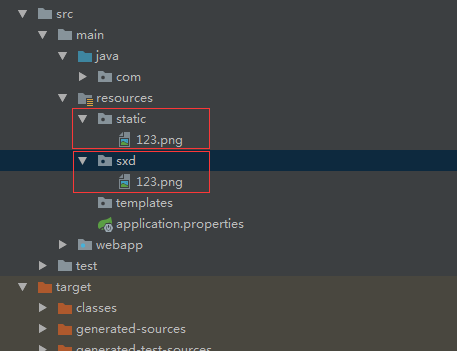
这个图片就是放在项目中,新建的sxd目录下

然后检测一下是否自定义的配置可以成功,同时可以检测到 自定义的静态资源映射地址和默认的映射地址哪个的优先级更高
访问之后发现,访问到的是自定义的映射文件地址下的图片。
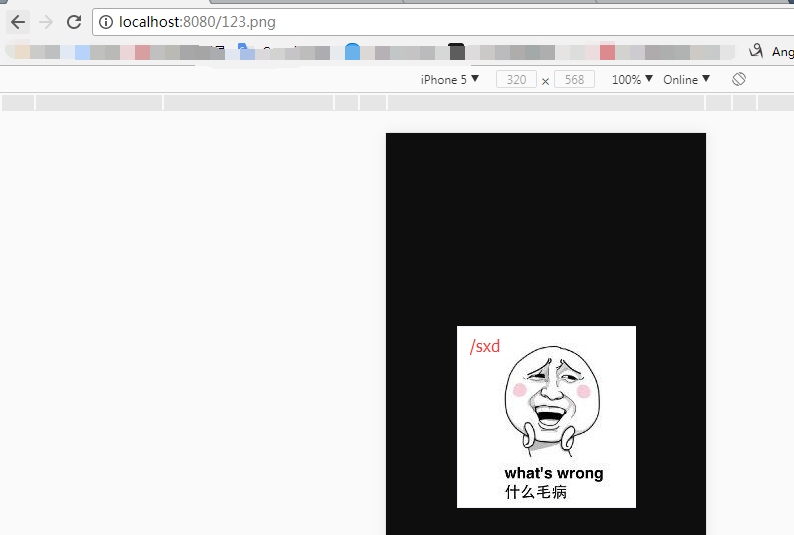
那我们修改一下上面的代码:


package com.sxd.util; import org.springframework.context.annotation.Configuration; import org.springframework.web.servlet.config.annotation.ResourceHandlerRegistry; import org.springframework.web.servlet.config.annotation.WebMvcConfigurerAdapter; @Configuration public class MyConfig extends WebMvcConfigurerAdapter { @Override public void addResourceHandlers(ResourceHandlerRegistry registry) { registry.addResourceHandler("/sxd/**").addResourceLocations("classpath:/sxd/"); super.addResourceHandlers(registry); } }
访问地址:http://localhost:8080/123.png
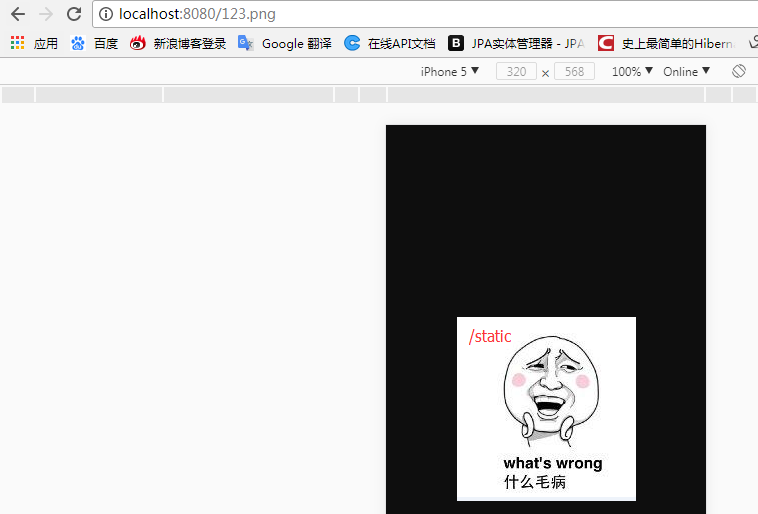
访问地址:http://localhost:8080/sxd/123.png
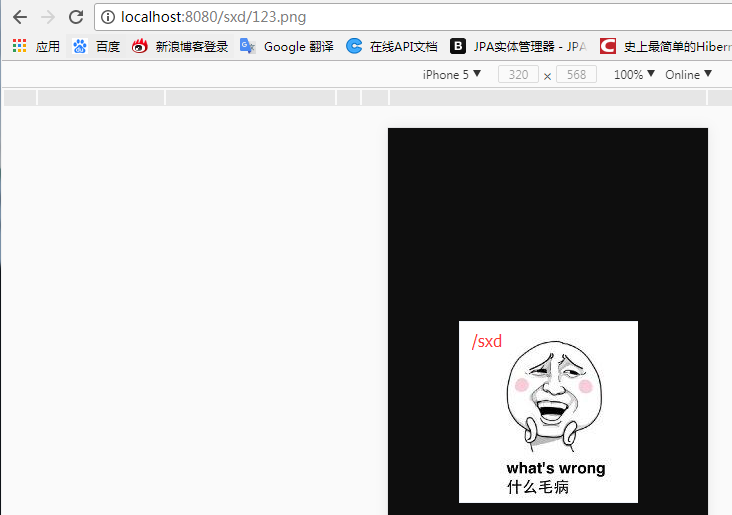
可以看出,即使是添加了自定义的静态资源映射地址,原本默认的地址依旧可以起作用。
同样的,修改【addResourceLocations("file:E:/壁纸/");】可以指定本地磁盘目录为静态资源访问路径
本地磁盘目录如下:



package com.sxd.util; import org.springframework.context.annotation.Configuration; import org.springframework.web.servlet.config.annotation.ResourceHandlerRegistry; import org.springframework.web.servlet.config.annotation.WebMvcConfigurerAdapter; @Configuration public class MyConfig extends WebMvcConfigurerAdapter { @Override public void addResourceHandlers(ResourceHandlerRegistry registry) { registry.addResourceHandler("/sxd/**").addResourceLocations("file:E:/壁纸/"); super.addResourceHandlers(registry); } }
然后重启访问:

最后,再次申明一点:
addResourceHandler("/**") 代表根访问路径,也就是localhost:8080/,就是对外暴露的地址
addResourceLocations("classpath:/sxd/"); 代表规定classpath下的/sxd/为静态资源的映射地址,就是文件存放的目录
==============================================================================================================
2.2 重写addViewControllers()方法,实现页面跳转的简便化
前面有spring boot项目访问jsp页面:http://www.cnblogs.com/sxdcgaq8080/p/7712874.html
要访问页面,还得创建一个controller,然后controller中还得写一个页面跳转的方法,才能访问跳转成功。
好现在创建一个hello2页面
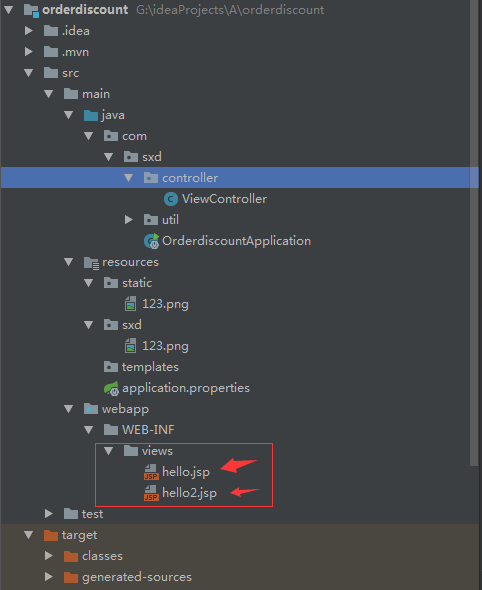
现在


package com.sxd.util; import org.springframework.context.annotation.Configuration; import org.springframework.web.servlet.config.annotation.ResourceHandlerRegistry; import org.springframework.web.servlet.config.annotation.ViewControllerRegistry; import org.springframework.web.servlet.config.annotation.WebMvcConfigurerAdapter; @Configuration public class MyConfig extends WebMvcConfigurerAdapter { @Override public void addViewControllers(ViewControllerRegistry registry) { registry.addViewController("/helloS").setViewName("hello2"); super.addViewControllers(registry); } }
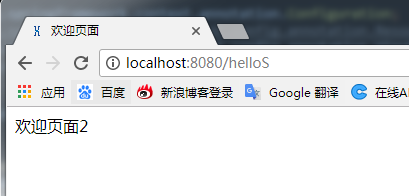
同时咱们原来的controller中原来的访问方式依旧是可以访问到的。


package com.sxd.controller; import org.springframework.stereotype.Controller; import org.springframework.web.bind.annotation.RequestMapping; @Controller public class ViewController { @RequestMapping("/hello") public String hello(){ return "hello"; } }
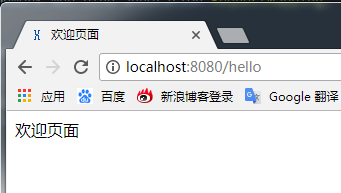
现在把controller中的访问地址和自定义配置中的这个访问地址设置为一样的,
controller:
@Controller public class ViewController { @RequestMapping("/hello") public String hello(){ return "hello"; } }
配置类:
@Override public void addViewControllers(ViewControllerRegistry registry) { registry.addViewController("/hello").setViewName("hello2"); super.addViewControllers(registry); }
然后重启,访问:
contrller和自定义配置类的页面跳转相比较,controller中优先有效。
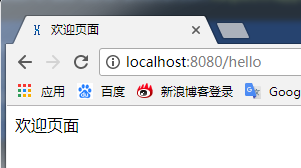
最后,如果想添加多个页面跳转,怎么办 ?
看下面代码:
@Configuration public class MyConfig extends WebMvcConfigurerAdapter { @Override public void addViewControllers(ViewControllerRegistry registry) { registry.addViewController("/hello2").setViewName("hello2"); registry.addViewController("/hello3").setViewName("hello3"); super.addViewControllers(registry); } }
重启,访问
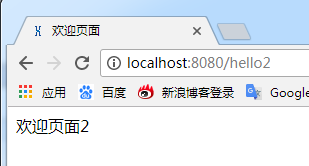
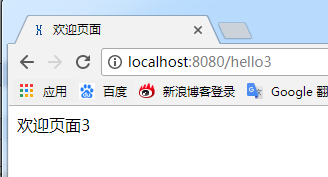
如此,甚好!!!!
===================================================================================================================
3.实现HandlerInterceptor 接口,重写addInterceptors方法实现自定义拦截器
好了,现在要实现自定义拦截器,在此之前我们需要做一些工作:
整个项目目录如下:
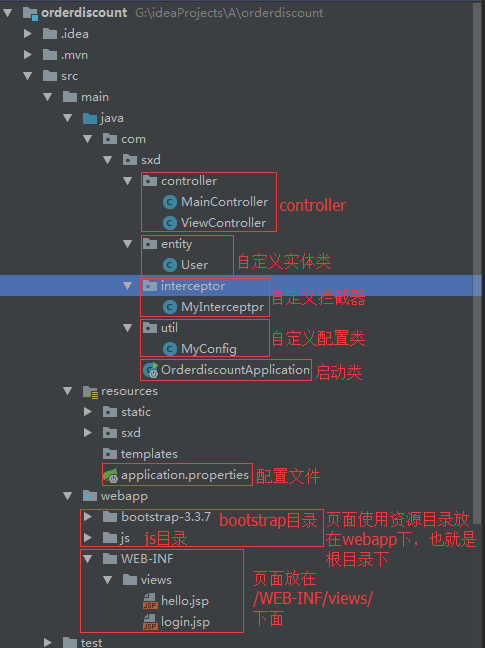
pom.xml文件如下:


<?xml version="1.0" encoding="UTF-8"?> <project xmlns="http://maven.apache.org/POM/4.0.0" xmlns:xsi="http://www.w3.org/2001/XMLSchema-instance" xsi:schemaLocation="http://maven.apache.org/POM/4.0.0 http://maven.apache.org/xsd/maven-4.0.0.xsd"> <modelVersion>4.0.0</modelVersion> <groupId>com.sxd</groupId> <artifactId>orderdiscount</artifactId> <version>0.0.1-SNAPSHOT</version> <packaging>jar</packaging> <name>orderdiscount</name> <description>orderdiscount for Spring Boot</description> <parent> <groupId>org.springframework.boot</groupId> <artifactId>spring-boot-starter-parent</artifactId> <version>1.5.8.RELEASE</version> <relativePath/> <!-- lookup parent from repository --> </parent> <properties> <project.build.sourceEncoding>UTF-8</project.build.sourceEncoding> <project.reporting.outputEncoding>UTF-8</project.reporting.outputEncoding> <java.version>1.8</java.version> </properties> <dependencies> <!--web 支持--> <dependency> <groupId>org.springframework.boot</groupId> <artifactId>spring-boot-starter-web</artifactId> </dependency> <!--jsp页面使用jstl标签--> <dependency> <groupId>javax.servlet</groupId> <artifactId>jstl</artifactId> </dependency> <!--用于编译jsp--> <dependency> <groupId>org.apache.tomcat.embed</groupId> <artifactId>tomcat-embed-jasper</artifactId> <!--<scope>provided</scope>--> </dependency> <!--spring boot热部署插件--> <dependency> <groupId>org.springframework.boot</groupId> <artifactId>spring-boot-devtools</artifactId> <optional>true</optional> </dependency> <dependency> <groupId>org.springframework.boot</groupId> <artifactId>spring-boot-starter-test</artifactId> <scope>test</scope> </dependency> </dependencies> <!--开启热部署--> <build> <plugins> <plugin> <groupId>org.springframework.boot</groupId> <artifactId>spring-boot-maven-plugin</artifactId> <configuration> <fork>true</fork><!--这个必须加上--> </configuration> </plugin> </plugins> </build> </project>
application.properties 配置文件:
spring.mvc.view.prefix = /WEB-INF/views/
spring.mvc.view.suffix = .jsp
User实体:

启动类:


package com.sxd; import org.springframework.boot.SpringApplication; import org.springframework.boot.autoconfigure.SpringBootApplication; @SpringBootApplication public class OrderdiscountApplication { public static void main(String[] args) { SpringApplication.run(OrderdiscountApplication.class, args); } }
登录页面跳转控制器--MainController跳转登录:
【访问localhost:8080/toLogin】就去找了根路径下的login.jsp页面,也就是classpath:/WEB-INF/views/login.jsp


package com.sxd.controller; import org.springframework.stereotype.Controller; import org.springframework.web.bind.annotation.RequestMapping; @Controller public class MainController { @RequestMapping("/toLogin") public String hello(){ return "login"; } }
登录时验证用户信息控制器--ViewController验证控制:
【如果用户名和密码都不为null,返回1,代表登录成功,并且放入session;否则返回2】


package com.sxd.controller; import com.sxd.entity.User; import org.springframework.stereotype.Controller; import org.springframework.web.bind.annotation.RequestMapping; import org.springframework.web.bind.annotation.ResponseBody; import javax.servlet.http.HttpServletRequest; import javax.servlet.http.HttpServletResponse; @Controller public class ViewController { @RequestMapping("/login") @ResponseBody public String hello(HttpServletRequest request, HttpServletResponse response, User user){ System.out.println(user); if(!"".equals(user.getUsername()) && !"".equals(user.getPassword())){ request.getSession().setAttribute("user",user); return "1"; }else{ return "2"; } } }
登录页面login.jsp:


<%-- Created by IntelliJ IDEA. User: SXD Date: 2017/11/15 Time: 13:51 To change this template use File | Settings | File Templates. --%> <%@ page contentType="text/html;charset=UTF-8" language="java" %> <!DOCTYPE html> <html lang="zh-CN"> <head> <title>登录页面</title> <link href="/bootstrap-3.3.7/css/bootstrap.min.css" rel="stylesheet"> </head> <body> <div class="container"> <h1 class="text-center">测试登录页面</h1> <form class="form-horizontal loginForm"> <div class="form-group-lg"> <label class="col-lg-2 control-label">用户名</label> <div class="col-lg-10"> <div class="input-group"> <span class="input-group-addon"><span class="glyphicon glyphicon-user"></span></span> <input class="form-control" name="username" type="text" placeholder="输入用户名"> </div> </div> </div> <div class="form-group-lg "> <label class="col-lg-2 control-label">密码</label> <div class="col-lg-10"> <div class="input-group"> <span class="input-group-addon"><span class="glyphicon glyphicon-lock"></span></span> <input class="form-control" name="password" type="password" placeholder="输入密码"> </div> </div> </div> <div class="form-group-lg"> <div class="col-lg-4 col-lg-offset-4"> <button class="btn btn-lg btn-primary btn-block" name="userLogin"><span class="glyphicon glyphicon-off"></span>登录</button> </div> </div> </form> </div> <script src="/js/jquery-3.2.1.min.js"></script> <script src="/js/login.js"></script> </body> </html>
登陆成功页面hello.jsp


<%-- Created by IntelliJ IDEA. User: SXD Date: 2017/11/14 Time: 14:59 To change this template use File | Settings | File Templates. --%> <%@ page contentType="text/html;charset=UTF-8" language="java" %> <html> <head> <title>欢迎页面</title> </head> <body> 登陆成功的欢迎页面!! </body> </html>

login.js


$(document).ready(function(){ /** * 登录 */ $("button[name='userLogin']").click(function(){ var user = $(".loginForm").serialize(); $.post("/login?"+user,function(data){ if(data == "1"){ location.href = "/toHello"; }else{ alert("登录失败"); } }); }); });
和题目描述一致,要实现拦截器功能,需要下面两个步骤:
1》》创建自己的拦截器类实现HandlerInterceptor接口,并重写对应的拦截方法
2》》重写WebMvcConfigurerAdapter中的addInterceptors方法,将自定义的拦截器类添加进来,并且规定拦截哪些,放过哪些地址
创建拦截器 MyInterceptpr.java
【需要实现HandlerInterceptor接口,重写preHandle()方法,判断session中是否有用户信息,若有则返回true并继续执行接下来的程序,否则返回false并重定向到登录页面】


package com.sxd.interceptor; import com.sxd.entity.User; import org.springframework.web.servlet.HandlerInterceptor; import org.springframework.web.servlet.ModelAndView; import javax.servlet.http.HttpServletRequest; import javax.servlet.http.HttpServletResponse; public class MyInterceptpr implements HandlerInterceptor{ /** * 预处理方法,handler执行之前调用 * @param httpServletRequest * @param httpServletResponse * @param o * @return true/false true即可执行之后的方法 否则 中断 * @throws Exception */ @Override public boolean preHandle(HttpServletRequest httpServletRequest, HttpServletResponse httpServletResponse, Object o) throws Exception { User user = (User) httpServletRequest.getSession().getAttribute("user"); boolean flag = false; if(user != null){ flag = true; }else{ flag = false; httpServletResponse.sendRedirect("/toLogin"); } return flag; } /** *handler执行之后调用 * @param httpServletRequest * @param httpServletResponse * @param o * @param modelAndView * @throws Exception */ @Override public void postHandle(HttpServletRequest httpServletRequest, HttpServletResponse httpServletResponse, Object o, ModelAndView modelAndView) throws Exception { } /** *本次request完成后调用 * @param httpServletRequest * @param httpServletResponse * @param o * @param e * @throws Exception */ @Override public void afterCompletion(HttpServletRequest httpServletRequest, HttpServletResponse httpServletResponse, Object o, Exception e) throws Exception { } }
创建拦截器之后,需要将自定义的拦截器添加到自定义配置类MyConfig.java中:


package com.sxd.util; import com.sxd.interceptor.MyInterceptpr; import org.springframework.context.annotation.Configuration; import org.springframework.web.servlet.config.annotation.InterceptorRegistry; import org.springframework.web.servlet.config.annotation.ViewControllerRegistry; import org.springframework.web.servlet.config.annotation.WebMvcConfigurerAdapter; @Configuration public class MyConfig extends WebMvcConfigurerAdapter { /** * 添加自定义拦截器 * @param registry */ @Override public void addInterceptors(InterceptorRegistry registry) { registry.addInterceptor(new MyInterceptpr()).addPathPatterns("/**").excludePathPatterns("/toLogin","/login","/js/**","/bootstrap-3.3.7/**"); super.addInterceptors(registry); } /** * 添加自定义页面跳转 * @param registry */ @Override public void addViewControllers(ViewControllerRegistry registry) { registry.addViewController("/toHello").setViewName("hello"); super.addViewControllers(registry); } }
.addPathPatterns("/**")要拦截的路径
.excludePathPatterns("/toLogin","/login","/js/**","/bootstrap-3.3.7/**")要放过的路径
/js/* 代表js下的子一级目录
/js/** 代表js下的所有子级
这样访问的时候,如果未登录就会跳转到login.html页面,而访问http://localhost:8080/toLogin 和http://localhost:8080/login 不会被拦截。
=========================================================================================================================================
注意就是:
1.js和css的目录都放置在webapp下,与/WEB-INF/同级而不是再其里面
2.资源如果放在静态资源的映射文件下,是可以直接引用到的。。。
如下,123.png放在static目录下
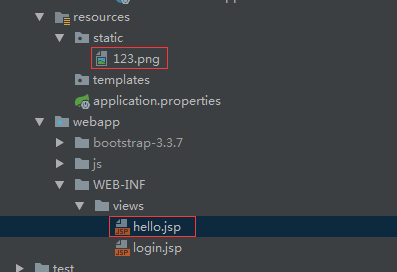
在页面上引用一下:


<%@ page contentType="text/html;charset=UTF-8" language="java" %> <html> <head> <title>欢迎页面</title> <link rel="stylesheet" href="/bootstrap-3.3.7/css/bootstrap.min.css"> </head> <body> <div class="container"> <div class="row"> <h1 class="text-center"> 登陆成功页面!!! </h1> </div> <div class="row text-center"> <img class="img-thumbnai" src="/123.png"> </div> </div> </body> </html>
效果如下:
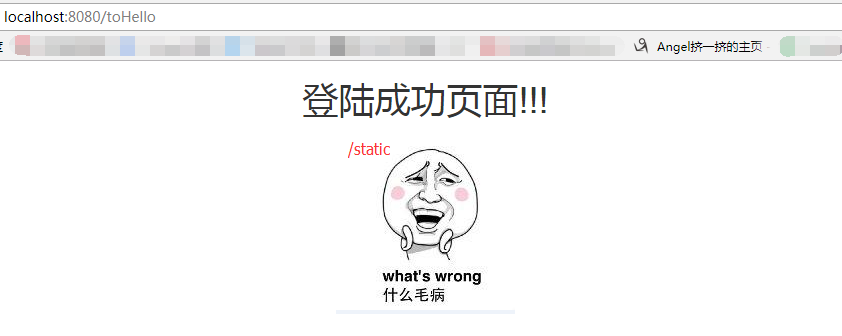
=========================================================================================================================================
更多配置可以查看WebMvcConfigurerAdapter的类的API。因其是WebMvcConfigurer接口的实现,所以WebMvcConfigurer的API方法也可以用来配置MVC。
只是实现这个接口的话,要实现所有的方法,这样还是很不方便的唉。
所以还是推荐使用继承WebMvcConfigurerAdapter类来处理。
=========================================================================================================================================
暂时就这样吧 !!!!